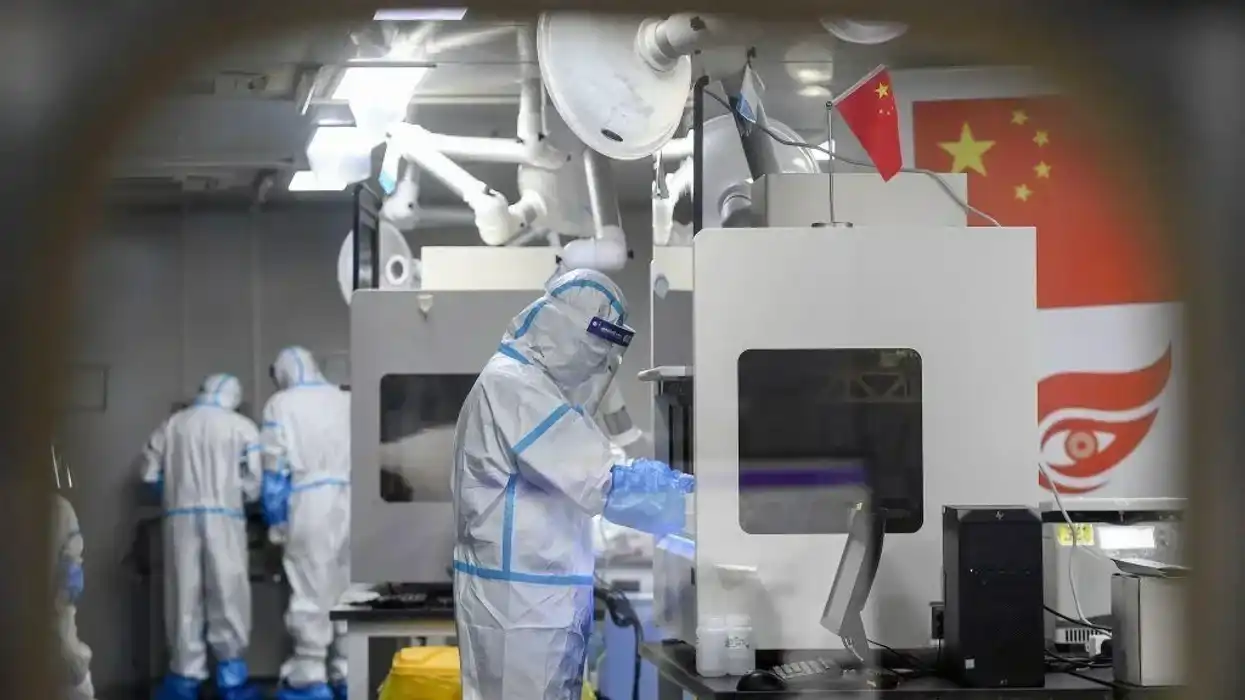
STR/AFP via Getty Images

Chinese scientists in Beijing have crafted a coronavirus variant called GX_P2V that kills humanized mice 100% of the time, largely with late-stage brain infections. The scientists indicated their mutant virus "underscores a spillover risk of GX_P2V into humans."
The study, regarded as pointless and dangerous by Western experts, comes amidst chatter by global elites about "Disease X," a hypothetical pestilence more lethal than COVID-19, and just days after a British report revealed lab leaks of deadly pathogens occurred frequently, even in labs with ostensibly better standards than those observed in China.
The preprint of the study, published earlier this month in BioRxiv, details how coronaviruses allegedly derived from the scaly anteaters known as pangolins ahead of the COVID-19 pandemic were grown in a lab in 2017 and 2020, then tested on mice.
The researchers, including a former Chinese military biosecurity expert, cloned a mutant version of the 2017 strain, which was initially able to infect both golden hamsters and mutant mice. The mice had been humanized — altered to express human ACE2, the receptor used by SARS-CoV to gain entry into human cells.
"We found that the GX_P2V(short_3UTR) clone can infect hACE2 mice, with high viral loads detected in both lung and brain tissues," wrote the researchers. "This infection resulted in 100% mortality in the hACE2 mice. We surmise that the cause of death may be linked to the occurrence of late brain infection."
When conducting autopsies on the humanized mice, the researchers detected "significant amounts of viral RNA in the brain, lung, turbinate, eye, and trachea of the GX_P2V C7 infected mice, whereas no or a low amount of viral RNA was detected in other organs such as the heart, liver, spleen, kidneys, tongue, stomach, and intestines."
The researchers also indicated the uncloned version resulted in 100% mortality in the humanized mice.
All mice infected with the live virus died with 7-8 days. Prior to their demise, the rodents began losing weight, reaching a 10% body weight decrease by the sixth day of infection.
By the seventh day, "the mice displayed symptoms such as piloerection, hunched posture, and sluggish movements, and their eyes turned white."
While the study references parallel work executed by Wuhan Institute of Virology scientist Dr. Shi Zhengli, an infamous virologist known as China's "bat woman," the New York Post suggested there appears to be no formal link between this study and the communist-run WIV.
The WIV was the epicenter of the COVID-19 pandemic, home to U.S.-funded gain-of-function experiments on coronaviruses, and the workplace of the likely COVID patients zero.
The 2023 Global BioLabs Report out of King's College London gave China an overall biorisk management score of 33 out of 48. The U.S., by way of comparison, scored 42. China's international biorisk management engagement score was 8 out of 14.
Largely through freedom of information requests, the Telegraph recently discovered that the U.K., which tends to rate higher on biosafety and biosecurity than China, saw a 50% increase in lab leaks and accidents since the pandemic.
Dr. Francois Balloux, an expert in infectious disease epidemiology and pathogen genomics at the University College London's Genetics Institute, said on X, "It's a terrible study, scientifically totally pointless. I can see nothing of vague interest that could be learned from force-infecting a weird breed of humanised mice with a random virus."
"Conversely, I could see how such stuff might go wrong," added Balloux.
American molecular biologist Richard H. Ebright of Rutgers University responded to Balloux's assessment, writing, "Concur."
Ebright suggested that contrary to a community note on X, the virus was not an "existing virus" prior to the experiments but rather a "new mutant variant constructed in laboratory by serial passage."
Ebright later noted, "Thank Fauci and Collins for encouraging this type of research."
Guennadi V. Glinskii, a former National Institutes of Health consultant and retired UC San Diego professor who specialized in personalized genomics-guided prevention, stressed, "This madness must be stopped before too late."
In the meantime, international elites appear to be working under the presumption the madness will not come soon enough.
Tedros Adhanom Ghebreyesus, the head of the World Health Organization, was joined by policymakers, corporate leaders in the pharmaceutical industry, and various technocrats at the World Economic Forum's meeting of the minders Wednesday to discuss preparations for "Disease X."
Ghebreyesus said, "Anything happening is a matter of when, not if."
The WHO director suggested further that COVID-19 could be thought of "the first Disease X," adding "it may happen again."
The WEF previously suggested that "Disease X" could "result in 20 times more fatalities than the coronavirus pandemic," reported Newsweek. The last virus out of China killed over 1.1 million Americans according to the CDC.
Like Blaze News? Bypass the censors, sign up for our newsletters, and get stories like this direct to your inbox. Sign up here!